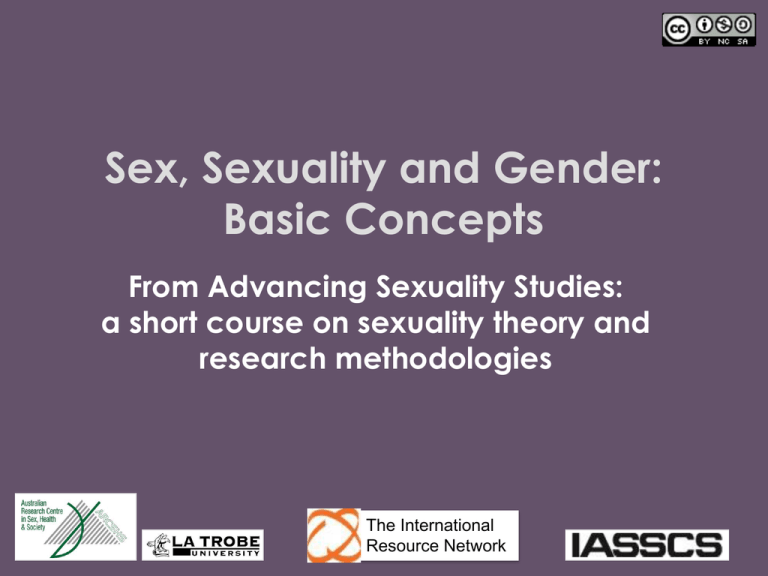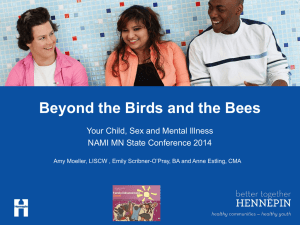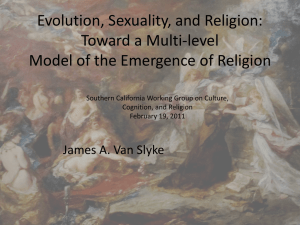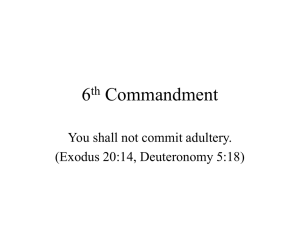
Sex, Sexuality and Gender:
Basic Concepts
From Advancing Sexuality Studies:
a short course on sexuality theory and
research methodologies
The International
Resource Network
Developed by:
The Caribbean International Resource Network
Presented in collaboration with:
The Institute for Gender & Development Studies at the
University of the West Indies, St. Augustine
(Trinidad & Tobago)
With funding from The Ford Foundation & the
International Association for the Study of Sexuality,
Culture and Society (IASSCS)
Available under an Attribution, Non-Commercial,
Share Alike licence from Creative Commons
2
Schedule
Learning activity
Introduction & aims
Time allowed
10 mins
Session 1. Challenging biological determinism and
defining sex, sexuality and gender
Group work & lecture (x2)
Reading images
Session wrap-up
160 mins
Session 2. Heteronormativity and sexual stratification
Introduction and lecture
Group work
Lecture & group work
100 mins
30 mins
20 mins
50 mins
Session 3. Understanding sexuality as historically &
socially constructed
or Transgender issues in cross-cultural perspective
Guided reading and group work
80 mins
Conclusion & personal reflection
45 mins
Total
130 mins
20 mins
10 mins
80 mins
395 mins
3
Module aims
To:
– Introduce and critique biologically determinist understandings of
sex, gender and sexuality
– Introduce Critical Sexuality Studies definitions of sex, sexuality
and gender and examine the history of the construction of
sexuality
– Examine the relationships between sex, sexuality and gender
through consideration of heteronormativity and sexual/gendered
inequity
4
Participants will:
– Critique biologically determinist constructions of sex and
sexuality
– Identify key theorists and concepts in the study of sexual
inequality
– Think critically about the relationships between sex, sexuality
and gender
– Reflect on the effects of normative constructions of sex,
sexuality and gender as these are relevant to their own
sociocultural and research settings
5
Session 1.
Challenging biological
determinism and defining sex,
sexuality and gender
6
Group work
• Divide into two groups
Group 1
– List differences between women and men and consider:
• On what are these perceived differences based? (e.g. biological, social,
cultural or religious beliefs)
Group 2
– List similarities between women and men and consider:
• On what are the perceived similarities based? (e.g. biological, social,
cultural or religious beliefs)
(10 mins)
• Feedback
(10 mins)
7
Discussion
• All participants to consider together:
– What are the effects of highlighting differences rather than
similarities between men and women?
– To what extent do assumptions about biologically determined sex
differences between women and men influence popular culture,
sayings or beliefs in the Caribbean?
(10 mins)
8
Biological determinism,
sex and sexuality
• Biologically determinist theories of various kinds reduce
social organisation and social complexity to an
effect of biology or nature
– Biological determinists include sociobiologists, some
geneticists, psychologists and ‘pop psychology’
writers
• Complex, socially embedded behaviours have
all been explained as an effect of evolutionary
reproductive strategies
9
• In the biologically determinist school of thought:
– Biological facts of sex are thought to constitute natural
differences between men and women
– Heterosexuality is considered a “natural” outcome of this sex
difference due to the drive to reproduce the species
• Key assumption driving biological determinism:
– The primary function and goal of all human
sexual activity is the reproduction of the species
• Humans have sex because we must reproduce
– Homosexuality becomes explained as an “unnatural”
genetic deviation
10
‘The gay gene’
• Geneticists search for a ‘gay gene’ to prove there is a
biological basis for, and explanation of, male homosexuality
– Small differences found between the post-mortem brains of
heterosexual and homosexual young men (LeVay, 1991)
– Research on pairs of homosexual brothers found that some had
similar markers on the X chromosome, indicating a genetic basis
for sexuality (Hamer et al. 1993)
• LeVay’s work proved difficult to replicate
• Hamer et al.’s work has been refuted
11
Challenging determinism
• If reproductive differences between the sexes “naturally”
drive individual behaviour, why do we need social
institutions that police and set moral guidelines for sexual
behaviour?
– The family, religion, government, the military…
• The research evidence for many biologically determinist
claims simply does not hold up
– Sex “difference” research may be popular, but it masks a great
deal of evidence for sex similarities
– Differences are often context-specific
12
• Despite continuing interest in a genetic basis for sexuality,
no gay or heterosexual gene yet found
• Most sex is not reproductive
– Human sexuality more complicated than ‘survival of the species’
or of one’s gene pool
• ‘Biological drive’ arguments are political
– Often used to resist social change and legitimate an unequal,
gendered and sexualised social order
– Institutionalised power relations affect understandings of sex,
gender, and sexuality
13
Definitions
• Write down your own definitions of the terms sex, sexuality,
and gender
(5 mins)
• Compare your definitions with those of the person next to
you
(5 mins)
• Each pair to report back to whole group
(10 mins)
• Brief group discussion
(10 mins)
14
Complexities of sex & gender
• Is there a difference? Yes, on one level
– Sex is biological – male, female, also intersex (reproductive
differences based on genitalia, chromosomes, hormones)
• Also refers to sexual acts, as in ‘having sex’
– Gender is ‘the structure of social relations that centres on the
reproductive arena, and the set of practices that bring
reproductive distinctions into social processes’ (Connell 2002: 10)
• Gender underlies assumptions regarding ‘masculine’ or ‘feminine’
behaviour
15
Hijra in India
Caster Semenya, South
African athlete
A ‘Tom’ in Thailand
Trinidadian
Jowelle De Souza
16
• Temptation to make an absolute distinction between sex
and gender:
– ‘Nature vs nurture’ or ‘essentialism vs social constructionism’
• Understanding of the sexed body as ‘natural’ can sustain
social inequity between men and women
• Butler (1990) argued that gender determines sex
– Sex is not ‘natural’ but a social construction
– Knowledge systems used to describe and reinforce sex
differences already gendered by the language used to express
ideas about the body
17
• Cannot neatly separate the sexed body from the gendered
body
– Mutually constituted through sociocultural processes
• Biological science is a social construction, expressed
through language which is gendered and value-laden
• In Critical Sexuality Studies, the ‘natural’ body is political
18
‘Bodies cannot be understood as just the objects of
social process…they are active participants in social
process...
They participate through their capacities, development
and needs … through the direction set by their
pleasures and skills.
Bodies must be seen as sharing social agency.’
(Connell 2002: 40)
19
Discussion
• Bodies have physical capacities and limitations
– These influence how bodies can be socially experienced or
intervened with
• In Critical Sexuality Studies:
– Sex, sexuality and gender necessarily involve various dimensions
of bodily and social capacities and phenomena
– These will be expressed differently in different sociocultural
settings
• Discussion
(5 mins)
20
What is ‘sexuality’?
• Quite a new term
– Came into English, French and German usage at the end of the
18th century
• Usually meant reproduction through sexual activity among plants and
animals
– Used in relation to love and sex matters in European discourse in
the 1830s
• What does it mean according to the dictionary?
– Depends on which dictionary you read
– Mirriam Webster (2013): The quality or state of being sexual
21
• Four intertwining strands of sexuality:
– Sexual desire or attraction
• To whom (or in some cases what) someone is attracted (physically and
emotionally)
– Sexual activity or behaviour
• What a person does or likes to do sexually (intercourse, masturbation, oral
sex, sexual fetishes)
– Sexual identity
• How someone describes their sense of self as a sexual being (e.g.
heterosexual, bisexual, lesbian, gay, homosexual)
– Sexual experience
• Observations of others’ sexualities; education or training related to
sexuality; experiences that may not have been consensual
• No clear boundaries!
22
The sexuality matrix
Desire
Behavior
Identity
Experience
23
General theoretical definition
Sexuality … [is] an historical construction which brings
together a host of different biological and mental
possibilities, and cultural forms — gender identity, bodily
differences, reproductive capacities, needs, desires,
fantasies, erotic practices, institutions and values — which
need not be linked together, and in other societies have not
been.
Weeks, J (2003: 7) Sexuality: Second Edition, Routledge
24
Caribbean theoretical
definition
Caribbean sexuality is “characterized by diversity” and
involves “embodied sexual practices, identities, knowledge,
and strategies of resistance of the colonized and
postcolonial subject” (2004: 2).
Kempadoo, K (2004: 2) Sexing the Caribbean, Routledge
25
• Are these images of sex, sexuality or gender?
• What would we need to know in order to make sense of this
question?
(5 mins + 5 mins feedback)
•
Images by Rodell Warner from the “Photobooth” series (2009-2011)
26
• Are these images of sex, sexuality or gender?
• What would we need to know in order to make sense of this
question?
(5 mins + 10 mins feedback)
27
Session summary
• Review the notes made at the start of the session on
definitions of sex, sexuality and gender and consider:
–
To what extent do they equate with working definitions so far?
(5 mins)
• Final questions or comments about this session?
28
Session 2.
Heteronormativity and
sexual stratification
29
Like gender, sexuality is political. It is organised into
systems of power, which reward and encourage some
individuals and activities, while punishing and suppressing
others.
Gayle Rubin (1984: 309)
30
Lecture
• Heteronormativity
… the institutions, structures of understanding and practical
orientations that make heterosexuality seem not only coherent—
that is, organized as a sexuality — but also privileged.
(Berlant and Warner (2000: 312))
• Heteropatriarchy
…the systems that support the combination of heteronormativity
and patriarchy (male dominance)
• Maintained and perpetuated by social institutions
– e.g. media, education, law, family, religion, healthcare systems
– usually through exclusion and marginalisation
31
Brainstorm
• Can you think of examples of heteronormative assumptions
that are present in the Caribbean?
(5 mins)
• Theories of sexual stratification:
Adrienne Rich and Gayle Rubin
– Offer opportunities for reconfiguring heteronormativity
32
Adrienne Rich
•
‘Compulsory heterosexuality and lesbian
existence’ (1980)
– Women’s Liberation era theorist and poet whose work was
influential in the development of lesbian and gay studies
• Heterosexuality is not a natural outcome of sex difference
– It is a social institution maintained by a series of inducements and
punishments for women
– Key question: ‘What social forces stop women from expressing
their sexual and emotional attraction to other women?’
33
Inducements & punishments
Inducements
Material
The marriage contract (legalised sexual subordination of women)
Financial and material support (husband)
Sphere of influence (the domestic)
Stay-at home child allowance for women
Reduced earning capacity for women compared with their male partners
Symbolic or ideological
Romance and love – made complete with a man (heterocoupling)
Female beauty as an ideal of female worth
Motherhood within marriage as female self-fulfilment
Women valued only insofar as they are valuable to men
Punishments •
Social ostracism for unmarried mothers, women who leave their husbands and
financially independent women
Women who are sexually independent labelled as ‘loose,’ ‘skettels,’ sluts’
Criminalisation, pathologisation and abuse of lesbians and women who are not
exclusively heterosexual
A system of gendered sexual violence that keeps women (and their sexuality) in its
proper place
34
Group work
• Divide into groups
• Using the handout supplied on Rich’s work re: inducements
and punishments, consider the following focus questions:
– Is this model of inducements and punishments relevant in the
Caribbean – historically and/or in the 21st century? If not, can it
be rewritten?
– Can this table be rewritten to apply to men?
(10 mins)
• Feedback
(10 mins)
35
Gayle Rubin
• Thinking Sex (1984)
– Hierarchies of sexual value
• People and practices high in the hierarchy rewarded with a range of
benefits, those low in the hierarchy punished and vilified
• Heterosexual couples who are married, monogamous and of the same
generation accrue more benefits than those who are not married and/or
who engage in more marginalised sexual practices
– What is more important:
• The sexual categories people fit into and the kinds of sex they have, or
• Democratic sexual morality: how people treat each other, their level of
mutual consideration and the presence or absence of harm and coercion?
36
Rubin’s ‘charmed circle’
• Form small groups
• Read the handout provided, and
share your understandings (5 mins)
• Discuss Rubin’s diagram in
relation to the sexual cultures,
identities and practices
relevant or currently topical
in the Caribbean
– Can you redraw the model to
fit our local setting? (15 mins)
• Feedback (10 mins)
37
Charmed circle: summary
• Diagram not intended to be a fixed representation of how
heteronormativity works at all times, in all places
– The inner circle boundary line can shift over time, and from place-toplace, for instance:
• Homosexuality was never illegal in French colonies but was criminalised
by the British in all of its colonies; today, same-sex marriage is technically
legal in the Dutch Caribbean territories that remain part of the Kingdom of
the Netherlands, but very few have been performed.
• Polygamy is illegal in Caribbean territories, but it is commonly practiced.
• Intergenerational sex between males was permitted in Ancient Greece but
is illegal in Greece now.
– Whoever controls the boundary determines what is normal and
abnormal, and controls the system of rewards and punishment
38
Session 3.
Either: Understanding
Caribbean sexualities as
historically and socially
constructed
or: Transgender identities in a
Caribbean context
39
Session 3, Option 1.
Understanding Caribbean
sexualities as historically and
socially constructed
40
Guided reading
• Read G. Wekker “What’s Identity Got to Do with it:
Rethinking Identity in light of the Mati Work in
Suriname.” (2005)
Or
• J. Alexander “Erotic Autonomy as a Politics of
Decolonization: Feminism, Tourism, and State in
the Bahamas and Trinidad and Tobago”
(30 mins)
41
Focus questions
(30 mins reading, 15 mins discussion, 30 mins feedback)
Alexander (2005):
Wekker (1999):
— According to Alexander, what is the
relationship between sexuality and
citizenship in the Bahamas and
Trinidad and Tobago?
— How would you describe mati to
someone who had never heard of
the practice?
— What is her concept of “erotic
autonomy,” and how can it be useful in
thinking about Caribbean sexuality?
— How is tourism implicated in
heteronormativy and heteropatriarchy?
— How are mati and lesbians
different? Why is it important to
Wekker not to label mati as lesbians
or bisexuals?
— How might mati work challenge
heteronormativity? How might it
reinforce heteronormativity?
42
Session 3, Option 2.
Transgender issues in
a Caribbean context
43
Guided reading
• Read Caricco (2012) Collateral Damage:
the Social Impact of Laws Affecting LGBT
Persons in Guayana
44
Guided reading
• Focus questions:
– How do Guyanese legal and cultural systems affect transgender people?
– What (if anything) in the reading is particular to the Caribbean and local
understandings of gender and sexuality?
– How can transgender identities challenge heteronormativity? How might they
reinforce heteronormativity?
– What challenges do transgender individuals present for biological determinists?
• Discuss in small groups, and consider:
– Can you add case studies of your own to support the argument that
sexuality is historically and culturally constructed?
(15 mins)
• Feedback
(30 mins)
45
Conclusion
• In Critical Sexuality Studies, human sexuality is understood
as:
– Diverse
– Dynamic and
– Deeply inventive
• The field challenges fixed notions of sex, gender and
sexuality
• It grounds the interrelationship between these concepts in
specific social, historical, cultural contexts
46
• Critical Sexuality Studies challenges the notion that sex
and sexuality are biologically determined, but:
– This does not mean the body or biological limitations/capacities
are irrelevant
• Sex, sexuality and gender are invariably linked to power
relations—institutional and interpersonal—and to systems
of regulation and reward
• Heteronormativity and heteropatriarchy exist across the
world, but take variable forms
47
Personal reflection
• In pairs: discuss the aspect of the module that you
personally found to be the most thought-provoking
(5 mins)
• Individually: note down any ways in which this module
might influence future research or work you undertake
(5 mins)
• In pairs: discuss your notes on the possible future influence
of the module on your work or research
(10 mins)
• Reflection sharing
(10 mins)
48
Module adapted for the Anglophone Caribbean by:
Dr. Rosamond S. King, The Caribbean International Resource
Network
Original module created by:
Dr Deb Dempsey, Swinburne University of Technology and Mr William Leonard,
Australian Research Centre in Sex, Health and Society with supporting material from
Professor Gary W. Dowsett, Australian Research Centre in Sex, Health and Society
Caribbean short course developed by:
The Caribbean International Resource Network
with the Institute for Gender & Development Studies, The University of
the West Indies, St. Augustine, Trinidad & Tobago
Original short course developed by:
The Australian Research Centre in Sex, Health and Society, La Trobe
University, Melbourne, Australia and The International Association for
the Study of Sexuality, Culture and Society (IASSCS)
With funding from The Ford Foundation
Available under an Attribution, Non-Commercial, Share Alike licence
from Creative Commons
49









